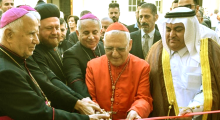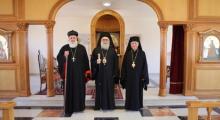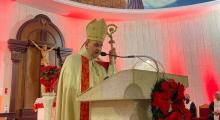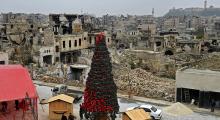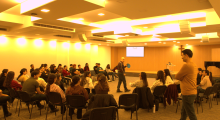Issued by the Catholic Center for Studies and Media - Jordan. Editor-in-chief Fr. Rif'at Bader - موقع أبونا abouna.org
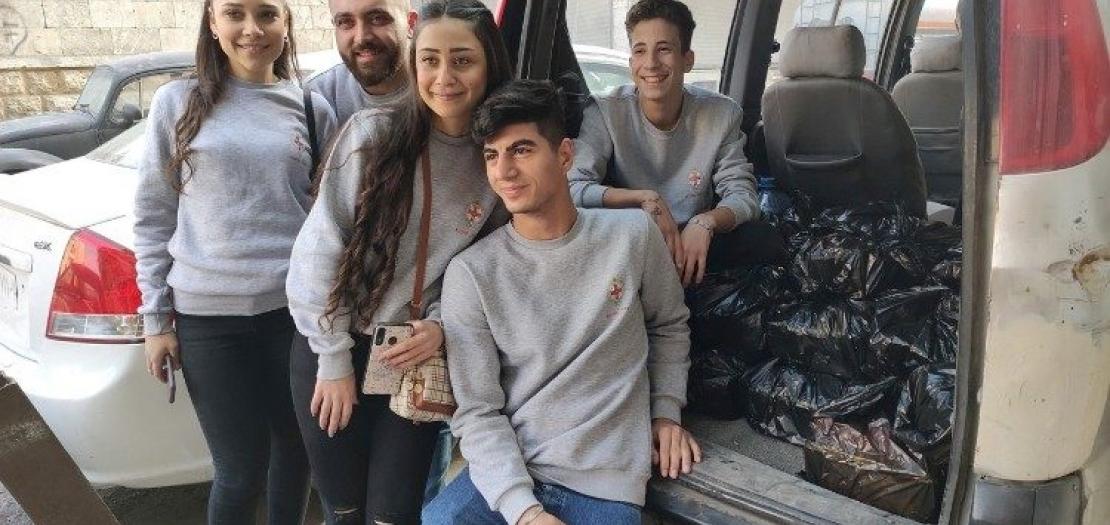
Aleppo was the most populous city in Syria before the war, followed by Damascus. This is no longer the case today. Syrians, who have gone abroad seeking a better future, have left behind an estimated 1.8 million inhabitants. They were 4.6 million in 2010. You only have to look at the windows to realize how many houses are empty and have been abandoned.
Visible and invisible scars
The war will leave deep, visible and less visible, scars in the heart of the city for years to come. Arriving from the south, you may not realize the extent of the destruction caused by the bombings. During the war, the Syrian army occupied the south of the city, while the "rebels" and "terrorists" occupied the northern quarters.
"You can't see the destruction in the south”, an Aleppo inhabitant explains. "The terrorists were less equipped than the regular army. They didn’t have heavy weapons, so the damage is more limited. On the other hand", he continues " if you go in the northern part, you can see the consequences of the aerial bombardments by the Russian air forces supporting the Syrian army". He further explains that it is quite easy to tell if a house has been bombed from the sky: "Bombs dropping from planes completely flatten buildings, like a mille-feuille", he says.
The Carmelite Sisters of Aleppo have a direct experience of the weapons used: on the evening of October 22, 2016, they heard a hissing noise in the air. The Superior, Sister Anne-Françoise, still remembers the six-meter missile which crashed into the convent garden but did not explode. She never knew where it came from: the Syrian deminers who came to extract the device wouldn’t say. But she claims she was protected by Saint John Paul II, who is celebrated on that day.
The most dramatically hit part of Aleppo is in the Old Town, which was recognized as a UNESCO World Heritage Site: there is hardly anything left of it. In fact, it was the epicenter of the fighting between the two sides. Nothing has been rebuilt since. The rubble is still there, pushed to the side of streets to allow cars to pass. The narrow streets of the historic center have become paths lined with mounds of debris and waste of all kinds.
Fratelli tutti before Laudato Sì
The situation of Aleppo inhabitants today is such that the only way out is fraternal mutual help: between Christians, between Christians and Muslims, between everybody in the city. Cleaning up waste, unfortunately, will have to wait.
Father Hugo Fabian Alaniz, a priest from Argentina, settled in the poorest district of Aleppo four years ago. During the siege this was the red zone from which no one could either enter or leave, because of the roadblocks and, above all, because of the snipers shooting from the buildings.
He rebuilt his church and little by little he is expanding his parish, not out of delusions of grandeur, but to help a growing number of families in need. Every day, voluntary students hold tutoring lessons for children in the converted basement of the parish. There are sewing and cooking laboratories, and all sorts of activities for the 1,200 families supported by the parish. The cooking laboratory prepares meals delivered to homes. The sewing laboratory recycles second-hand clothes. Nothing is thrown away.
How he manages with so little is a daily miracle. When he moved here four years ago, he took in 24 children. There are over 500 of them today. “Families get to know about us by 'word of mouth', and it never stops,” he says.
His parish also welcomes the deaf and people with hearing impairment. It's a swarm of people coming in all day long. A place of life, and of faith.
A drop of milk
In a small street in Aleppo we find a store with two young volunteers dressed in light blue jumpers distributing powdered milk to families. It’s called "A Drop of Milk" and is run by the Marist Brothers. The association provides one kilogram of powdered milk per month to 3,000 families with young children, and condensed milk for newborn babies. It’s unique in its kind: indeed it is the only association in the whole city providing such a service.
Milk is a luxury here. At 12,000 Syrian Liras per kilo, with an average salary of 65 to 70,000 Liras, milk is inaccessible to most people. The volunteers distributing the milk make sure that each family doesn’t get more than needed and open each pack so that the milk is not resold on the black market. At this price, powdered milk is like gold.
The Armenian orphanage
Among the Christian communities involved in helping there is also the Armenian Apostolic community. Every day the Armenian Orthodox distribute hot meals to the elderly in front of their cathedral. Most of the people served are from the Armenian community, but, here too, the poor are helped whatever their religion. In the premises of the parish, volunteers prepare Armenian dishes, package them, and distribute the food pack to the pensioners cueing outside. They are all very dignified looking people: nothing suggests that they are in a situation of great poverty.
"The poor never ask", a cleric tells us. "They accept what we give to them, but they don't come begging," he says, explaining that all these people were well off before the war, as can be seen from their clothes and their education. But after 10 years of war and 5 years of economic crisis, they have nothing left.
On the first floor of the building, the Armenian community has opened an orphanage for 38 boys and girls aged from 8 to 22. Each one has a different story to tell. Marina, 21, arrived here after fleeing Hassakah in the north, where her father and brother were killed by Islamist militiamen. Marina has two sisters: one lives in Jordan and the other in Damascus, but cannot host her. They have also lost their mother who died from a serious illness.
Very strong bonds have been created in the orphanage: children consider themselves as brothers and sisters, and call the supervisory staff "tata" (auntie). Those who have left the institution and who are still in Syria often return for their holidays. Former residents who have gone to live abroad send money to support it.
The Greek Orthodox relief center
Not far from the Armenian cathedral, the Greek Orthodox Church has also established a relief center. The queue begins on the sidewalk. Inside, needy families receive vouchers. The volunteers have also just received a delivery of warm shoes for the winter.
“All that can be done is done”, says an official at the center, while opening an envelope containing 47,000 Syrian Liras for an elderly person. Not much, considering that one kilogram of meat costs more than that, and that electricity supplied by privately owned collective generators costs 15,000 Syrian Liras per ampere per week, which is just about enough to light a few light bulbs, but not to switch an oven or a washing machine on.
The Greek Orthodox Church distributing money to the needy
Over 800 meals are also served each day and seventy percent of those assisted are over the age of seventy. Young people have already gone, the elderly are just trying to survive.
Aleppo had 300,000 Christians before the war, only 20,000 remain now. Help from the Churches is crucial for these people.


